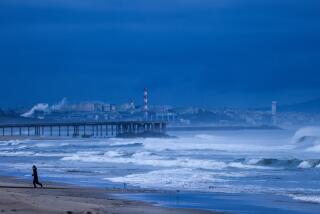Heavy Rains Set Off Mudslides, Floods as Storm Pounds State
Heavy rain and winds walloped the entire California coast on Friday as a powerful Pacific storm worked its way south, causing at least one death, driving floodwaters into homes and businesses, closing roads, causing massive power outages and drenching an already soggy state.
In Northern California, nervous residents warily watched the Russian and Napa rivers, which crested above flood levels in the early morning hours and receded in early afternoon. But rain continued to pelt the region, threatening new flooding and leaving more than 100,000 homes and businesses in several counties without power.
“It feels the same as ’86. I’m having post-traumatic flood disorder,” lamented a somber Patti Jackson as she surveyed the turbulent Napa River and recalled the last time flooding had been so bad.
For most of the day, Southern California escaped the heavy soaking that was forecast to batter the region, but by nightfall thunderstorms and winds slashed across the area.
About 8:30 p.m., a clap of thunder shook buildings in the Downtown area and set off several car alarms. A 17-year-old Carpinteria girl was briefly hospitalized after lightning struck precariously close to a group of high school track athletes practicing in a downpour about 4 p.m.
Storm damage led to closure of several key highways in the region.
Major mudslides prompted authorities to close Pacific Coast Highway from Topanga Canyon Boulevard to Carbon Canyon Road. The northbound side of the coast road already was blocked south of the McClure Tunnel.
U.S. 101 northbound was shut down near Manchester Canyon in Santa Barbara County, and also at Bates Road and California 33 in Ventura County. Interstate 5 was flooded and closed near the intersection of California 99 just north of the Grapevine. Interstate 5 also was closed in dozens of other places along a 200-mile stretch through the Central Valley.
On the rain-slickened freeway, which is California’s major north-south route, an 18-wheeler hit several cars, killing one motorist, the California Highway Patrol said.
Rain was expected to continue through today, heavy at times and with a chance of more thunderstorms, before tapering off Sunday.
Storm-related damage to the California Aqueduct in the Central Valley will shut off the flow of water to Southern California for several days, officials said. The aqueduct, which brings water south from the Sacramento River delta, sprung a leak near Pearblossom and suffered other damage just south of Fresno that is expected to take several days to repair. Metropolitan Water District officials said that reservoirs south of the leaks have sufficient water to serve customers until the aqueduct is fixed.
In Ventura County, another portion of the La Conchita landslide gave way, sending a river of mud, rocks and water down the hill and forcing authorities to evacuate at least 10 of the residents remaining in the beachside community that suffered a 600,000-ton landslide that crushed nine dwellings one week ago.
Geologists have declared the hillside that looms over the community extremely unstable, with smaller chutes of dirt ready to go any time. And officials have asked the entire community to evacuate, declaring 140 homes too hazardous for residents to stay overnight.
Heeding that advice, most residents had skipped town by Friday, leaving behind a mud-caked neighborhood overrun with disaster workers and media crews from throughout the state and overseas.
Up north, rescue workers in helicopters lifted out dozens of people trapped by floodwaters in Monterey County, and several hundred people evacuated their homes in the Carmel Valley after water jumped two dams and turned the Carmel River into a raging, debris-strewn torrent.
Santa Cruz County also took a beating as mudslides forced authorities to shut down California 17, the main artery connecting the county to San Jose. Some evening commutes stretched to nearly three hours as drivers had to take alternate routes home. The San Lorenzo River was reported at its highest levels since a series of destructive floods in the early 1980s.
In San Jose, the Guadalupe River overflowed its banks and flooded the downtown area, shutting down the city’s light-rail system and forcing cancellation of Friday night’s hockey game between the San Jose Sharks and the Detroit Red Wings.
In the Sierra Nevada, Mammoth Mountain received six feet of snow, and officials said they expect an additional three feet before the storm is over. Despite conditions described by ski-area personnel as “epic,” few were able to enjoy it Friday as officials shut down lifts because of the danger of lightning. Many other ski areas were closed because of high winds.
“It’s a pretty potent storm and there could be heavy rainfall and several inches of rain over the mountains, from the San Gabriels northward,” said Curtis Brack of WeatherData Inc. Winds up to 60 m.p.h. were predicted overnight Friday for the San Bernardino and Tehachapi mountains.
With a low pressure trough sitting off the West Coast, the storm is pulling in a continuous stream of moisture from the ocean.
As of Friday afternoon, up to 13 inches of rain had been dumped on the Central California coast over two days, while the Russian River Valley was awash with eight to 11 inches of rain.
In San Luis Obispo County, emergency crews worried about getting potable water and emergency medical care to residents in the small, scenic community of Cambria, cut off by mud, fallen trees, an impassable bridge and waist-high water.
About 70 businesses were flooded by Friday morning, some of them inundated by pools almost seven feet deep. The tourist town had been drenched with eight to 10 inches of rain in less than 24 hours, said Jeff Ham, a county emergency services spokesman.
Trees “big enough to put a hole through your house” were falling in droves, Ham said. He said the county hoped to get medical crews stationed in the town because response in an emergency would take at least 45 minutes over narrow, mountainous roads.
“The back roads into Cambria are the kind for a scenic drive to look at wildflowers,” Ham said, “not the kind you would want to be driving on a day like this.”
Thirty-six residents, including children, of a rural community called Arroyo Seco in Monterey County had to be hoisted out of floodwaters on helicopter cables and slings after the Arroyo Seco River flooded their homes and mud blocked the only road to safety, said Catey Fisher, fire information officer for the California Department of Forestry.
St. Helena, a picturesque wine country town on the flooding Napa River, remained one of the worst hit, said Kerry Porterfield of the local Police Department. Four hundred people were evacuated Thursday from low-lying mobile home parks and two apartment buildings.
“We’re not letting ‘em back in,” he said. “The Weather Service said the river’s going back up to 18 feet.”
In Napa, the knee-high water that flooded the streets of the historic downtown in the early-morning hours Friday had largely subsided by afternoon, leaving a layer of thick mud in its wake.
Stores and homes throughout the city at the south end of the Napa Valley were dark. Sandbags were stacked in front of windows and doors and plastic tarps shielded storefronts. An estimated 200 to 300 residents were evacuated at the peak of the flooding overnight Thursday and an equal number of homes and businesses were filled with mud and water, said Randy Starbuck, a spokesman for the city of Napa.
City officials warned evacuees to stay away from their homes late Friday, as the community waited for more flooding. The National Weather Service forecast up to 5 more inches of rain for St. Helena, upriver from Napa.
More than 124,000 Pacific Gas & Electric customers in Central and Northern California remained without power Friday, down from a high of nearly 780,000 Thursday night, said Cory Warren, a PG & E spokesman.
The damage to power equipment was so great throughout the region that PG & E called for help from utilities as far away as San Diego and Oregon.
“In some ways it’s worse than the January storm,” Warren said. “In the first two days in January, we had 524,000 customer outages in 48 hours. This is almost 780,000 in 36 hours.”
In Napa, Brewster’s Army-Navy surplus store had to resort to its own stock of Coleman lanterns to light the cavernous store, one of the few open businesses in the city.
Marian Boyd, who learned last week that she had no flood insurance, saw the rising Napa River wash most of her belongings away Thursday night. Friday morning she was at Brewster’s buying lantern parts for her mini-market, which remained dry but powerless.
“We had a foot of water in our house,” Boyd said. “If it wasn’t for our friends we would have lost everything like in 1986. We were preparing to plant a berry orchard. Last week we bought a tractor and poles and supplies and things. It all floated away.”
Napa abounded with hard-luck stories Friday as residents and business owners assessed the damage under intermittent showers, waiting for the deluge expected around nightfall.
Gary Troughton, who moved to Napa after losing his truck driving job on Christmas Eve, grimly surveyed the foot of mud and water that coated the washer, dirt bikes, children’s toys and an infant car seat.
The waterline from this week’s flooding reached about three feet up the basement wall. Four feet above that, Troughton had memorialized January’s damage in blue spray paint--a wavering water line and the inscription, “Flood of Jan. ’95.”
“The stress from the storm has destroyed us,” he said. “Being laid off, trying to manage to put food in the kids’ mouths. My wife had a miscarriage, starting all over again. And then the floods. It’s hell.”
But not all was somber Friday. Downtown Joe’s Restaurant and Brewery hooked up a generator to run the espresso machine and chill the micro-brewery’s beer. A steady stream of diners escaped the dampness, swapping storm stories and drinking designer ale.
Residents of Guerneville in Sonoma County, which was hardest-hit in the January story, spent most of Friday watching the Russian River. County disaster officials said the region was largely without power but had so far escaped major damage.
Times staff writers Nieson Himmel and Bettina Boxall in Los Angeles, Richard Paddock in San Francisco and Julie Fields in Ventura contributed to this story. The Associated Press also contributed.
* VENTURA DRENCHED: Emergency workers answer dozens of reports of fallen trees and power lines. B1
More to Read
Sign up for Essential California
The most important California stories and recommendations in your inbox every morning.
You may occasionally receive promotional content from the Los Angeles Times.












